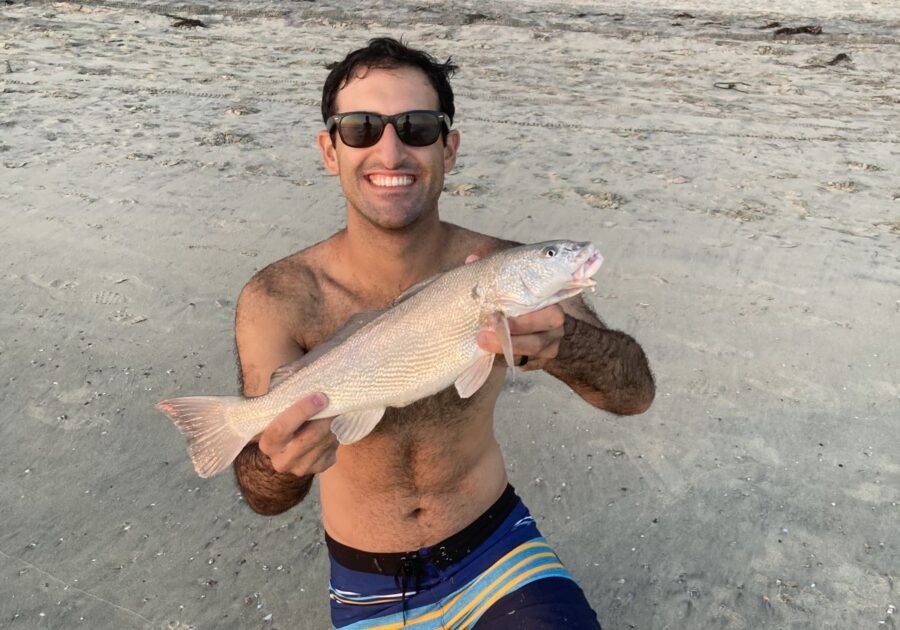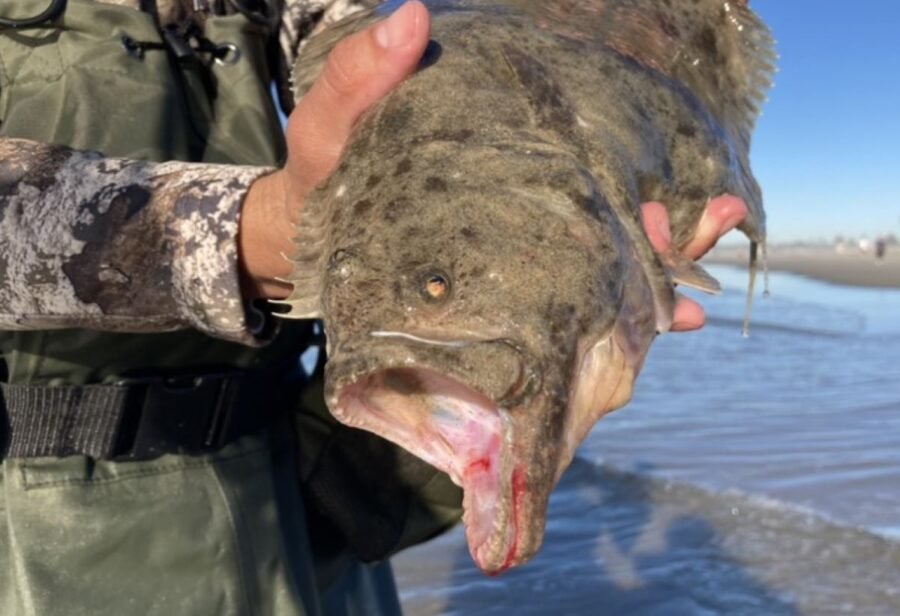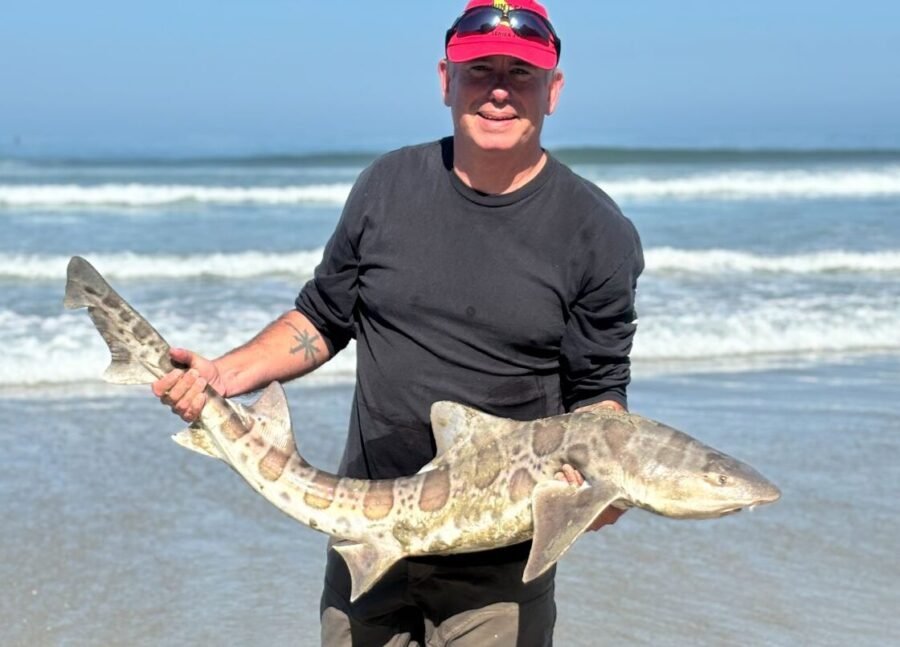Coronado State Beach: Surf Fishing Guide and How-To

Coronado beach is one of the most iconic stretches of sand (and real estate) in San Diego. What all those tourists and boardwalk-ers don’t know is that the surf fishing is actually quite good there. In this article, we’ll be providing a guide about everything you need to know for surf fishing Coronado beach.
Overview of Surf Fishing at Coronado Beach
| Parking Info | Free – Nearby parking can be tough in the summertime. Lots of options further from the water. |
| Ease of Access | Very Easy |
| Tides | Any Tide is Good |
| Crowds | More Crowded Than Most |
| Terrain Type | Mostly Sandy |
| No Fishing Areas | Two Naval Areas – Read Above |
| Recommended Gear and Tackle | Surf Fishing Gear and Tackle |
Coronado beach is one of the more interesting beaches I’ve come across. It’s produced some big corbina, some chunky yellowfin croaker, and some nice barred surfperch, and even some walleye surfperch!
Coronado Beach is one of the many flat, sandy beaches that San Diego has to offer. But, Coronado takes “flat and sandy” to a whole new level. It’s the one beach that consistently seems to lack much structure like troughs, scallops, and holes. It just seems like such a consistently flat, sandy beach.
Every now and then some troughs form, but it can be a challenge to find real defined holes here. Yet, the fishing is good. The lack of structure could be because of the unique swell direction given its angle, but all I know is that it’s tough to read the surf at Coronado.
What Fish Can You Catch?



Similar to many sandy so cal beaches, Coronado is a great spot for surfperch, corbina, croaker and all the other common species that feed on sand crabs.
There isn’t much hard structure, so the swimbait style used to target halibut, white seabass, and calico bass etc. isn’t a great fit here. Rather, jerkbaits for halibut and surfperch will do well. Check out the table below for a mostly comprehensive list of all the species you could potentially catch here.
| Common Species | Peak Season | General Season |
| California Corbina | Jun-Aug | May-Oct |
| Spotfin Croaker | Jun-Aug | May-Oct |
| Yellowfin Croaker | May-Aug | May-Oct |
| Barred Surfperch | Nov-Apr | Year-Round |
| Walleye Surfperch | Nov-Apr | Year-Round |
| Shovelnose Guitarfish | Jun-Aug | May-Oct |
| Sting Ray (Round Ray) | Jun-Aug | Year-Round |
| Bat Ray | Jun-Aug | Year-Round |
| Leopard Shark | May-Aug | Apr-Oct |
| California Halibut | Jan-May | Year-Round |
| Soupfin Shark | Mar-Jul | Year-Round |
Bait and Gear & Tackle
Your choice of bait should be dictated by your target species. For surfperch, corbina, croaker, guitarfish and all the bycatch that comes along with those, use sand crabs when they’re around. When sand crabs disappear in the colder months, use mussel meat. If you’re happy just catching perch, use grubs and curly tails or gulp sand worms.
For targeting halibut or larger surfperch, try using a jerkbait like the Shimano WM or the Lucky Craft FM 110. See below for the right gear and tackle for each method.
Light Tackle Gear
- Rod: Okuma Celilo (8’6″ MA) or the Okuma SST (8’6″ MA)
- Reel: Penn Battle II or III 4000 series
- Mainline: 15-pound monofilament
- For Bait: Carolina Rig:
- Leader Line: 15-pound fluorocarbon
- Swivels: 15-19mm barrel swivels
- Hooks: size #2 or #4 owner mosquito hooks
- Weights: 1-oz egg weight
- Beads: 8mm fishing beads
Swim Bait Gear
- Rod: Okuma SST-S-902HA – 1/2-2oz | 10-30lb | 9ft | H | MF
- Reel: Penn Spinfisher VI (3500 or 4500)
- Main Line: 30-pound braid
- Leader Line: 30-pound mono
- Lure Options:
Jerk Bait Gear
- Rod: Okuma SST (8’6″ MHA)
- Reel: Penn Battle II or III 4000 series
- Main Line:
- Leader Line: 15-pound fluorocarbon
- Lures: Lucky Craft FM 110 and Shimano WM 115 SP
Shark Gear
- Rod: Fiblink Moonsniper (12 or 13 feet)
- Reel: Penn Battle 8000 (II or III)
- Main Line: 50-pound braid
- Topshot: 100-pound nylon coated mono
- Leaders: Shark Leaders
- Weights: 8-ounce pyramid or 6-ounce sputnik
Parking at Coronado State Beach
Despite Coronado beach being known for heavy foot traffic and limited parking, it’s not too tough to find parking here. Obviously, it depends on your timing, but, anywhere along Ocean Boulevard and it’s many “cross streets” are usually a really good bet. Peak summertime can be tough to find parking.
YouTube Video of Surf Fishing at Coronado State Beach
Where to Legally Fish Coronado State Beach:
While there are no Marine Protected Areas here, there are two naval bases. One to the south and the other to it’s north. The naval base on the south end of Coronado Beach begins roughly on Avenida Lunar. The naval base on the north side is much more definitive and it begins where Dog Beach ends. There’s fencing there too so you don’t need to worry about accidentally wandering across the line. Usually, you cannot fish these beaches without explicit permission, so steer clear.
Tides for Fishing Coronado Beach
Coronado is another “any tide beach”. This is because there’s no limit to how high or low a tide this beach can handle. You won’t be backed into any cliffs and there’s a tremendous amount of sand. It’s also incredibly easy to access.
Type Of Structure
As mentioned earlier, Coronado is a mostly sandy beach with very little hard structure aside from the jetty off Hotel Del. Sand crabs, mussel meat, and jerkbaits are my most commonly used baits here for that reason. Most frequent catch will be surfperch, corbina, yellowfin croaker and spotfin croaker. If you’re using lures, surfperch and halibut will be your likely catches.
More Info
One thing I’ve noticed about Coronado beach is that sand crabs can be tough to find here even in peak summertime. I always recommend bringing a backup bait to Coronado for that reason. If you look hard enough, you should be able to find them, but it may be the least consistent spot for sand crabs in San Diego. To view guides like this for all the other best surf fishing beaches in San Diego, view the link.
I hope this guide helps and if you’re interested in booking me as your surf fishing guide, follow the link!